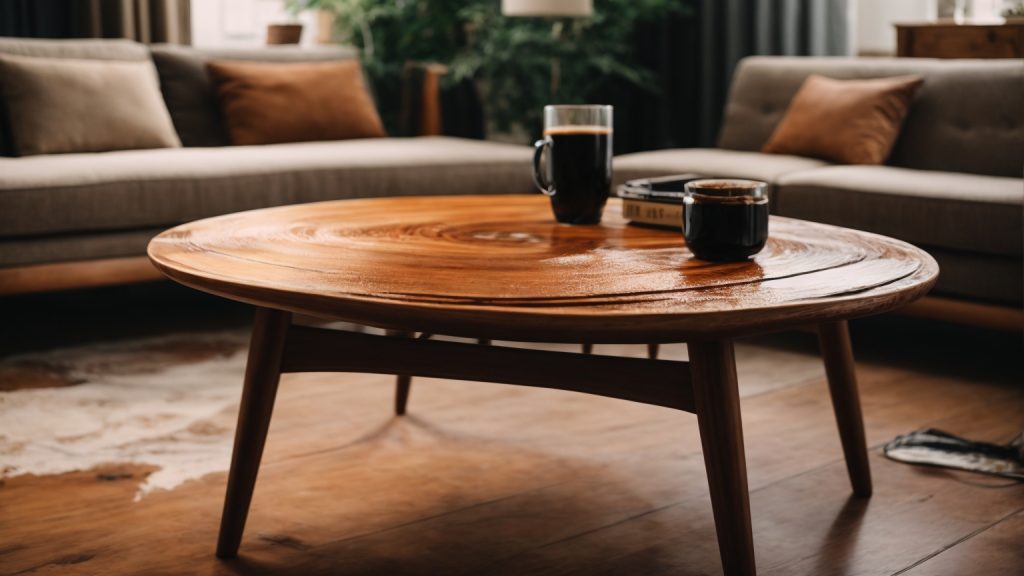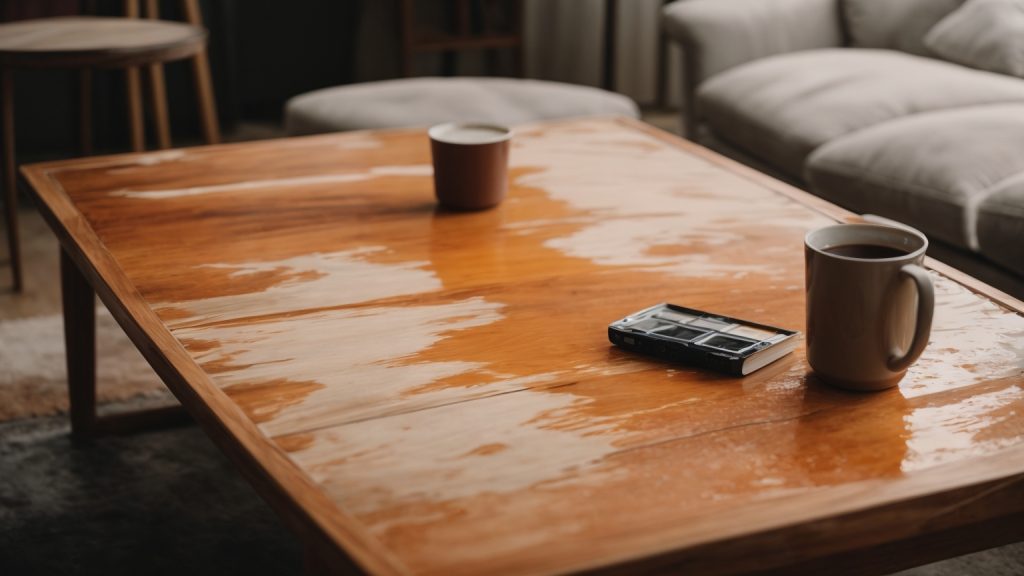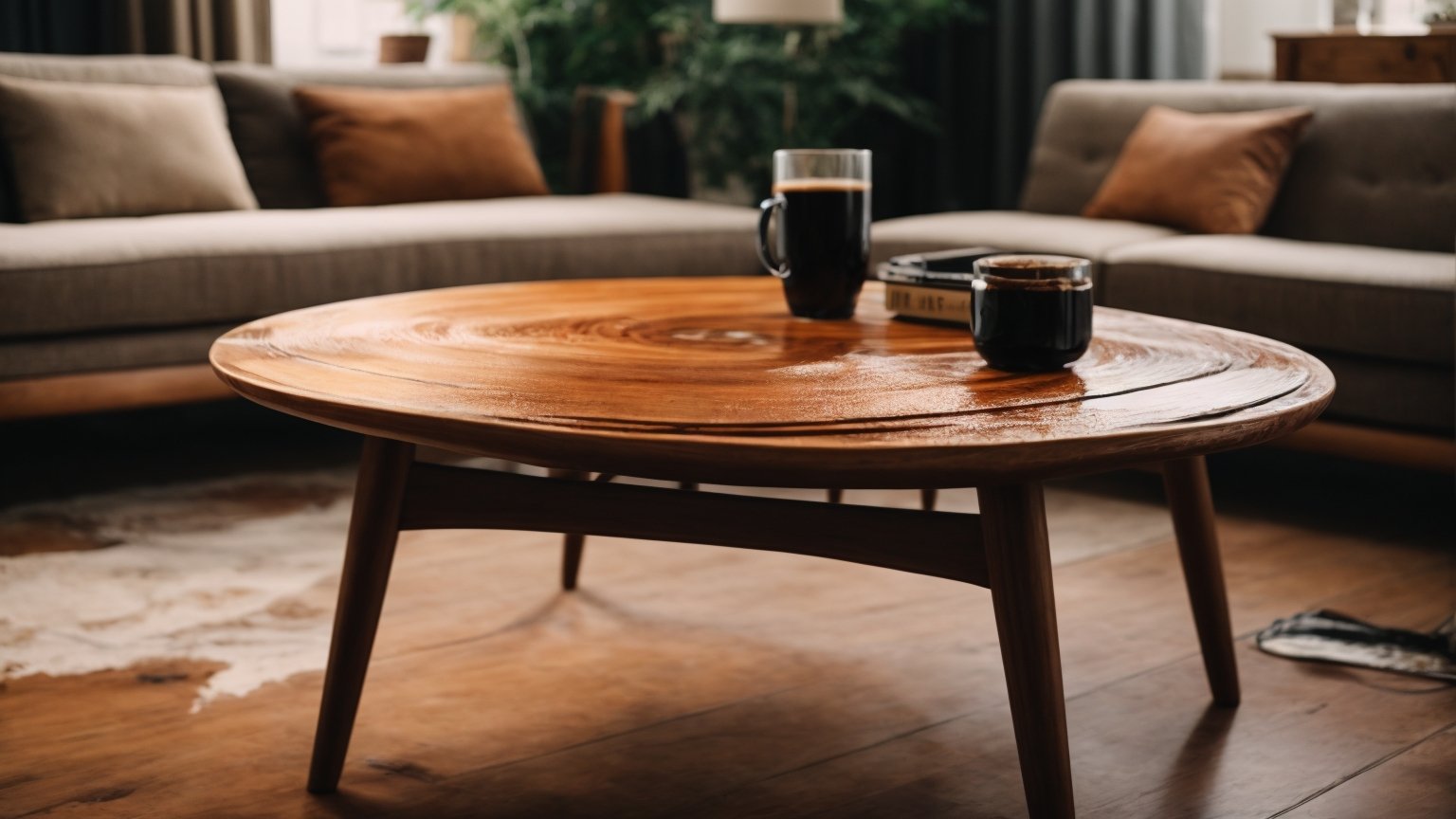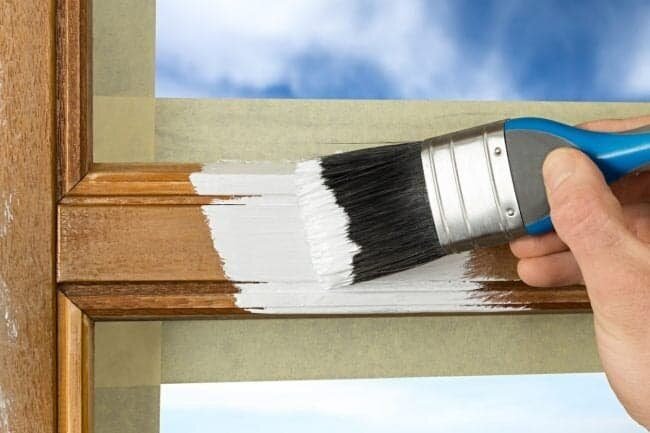Are you tired of your old and worn-out wooden coffee table? Painting it can be a great way to give it a fresh new look without having to spend a lot of money on a new one. However, painting a wooden coffee table can seem like a daunting task, especially if you’ve never done it before. But don’t worry, with a little bit of knowledge and some patience, you can transform your coffee table into a beautiful piece of furniture that will enhance the look of your living room.
The first step in painting your wooden coffee table is to choose the right paint and supplies. You’ll need a primer, paint, paintbrushes, sandpaper, and a clean cloth. Once you have all your supplies, the next step is to clean your coffee table thoroughly. This will ensure that the primer and paint adhere properly to the surface. After cleaning, you’ll need to sand the table to remove any bumps or rough spots. Once you’ve sanded the table, you’ll need to clean it again to remove any dust or debris.
Understanding the Type of Wood

Before you start painting your wooden coffee table, it’s important to understand the type of wood you’re dealing with. Different types of wood require different preparation and painting techniques to ensure the best results.
Identifying Hardwood and Softwood
The first step in understanding your wood is to identify whether it is hardwood or softwood. Hardwood comes from deciduous trees, such as oak, maple, and cherry, while softwood comes from coniferous trees, such as pine, spruce, and cedar. Hardwood is generally denser and more durable than softwood, but it can also be more difficult to work with.
To identify your wood, look at the grain pattern and color. Hardwood tends to have a more complex grain pattern, while softwood has a simpler, more uniform pattern. Hardwood also tends to be darker in color than softwood.
Checking for Wood Treatments
It’s also important to check whether your wood has been treated with any chemicals or finishes. If your wood has been previously painted or stained, it may have a layer of varnish or polyurethane that needs to be removed before you can paint it.
To check for wood treatments, look for any discoloration or staining on the surface of the wood. You can also try sanding a small area to see if the wood is absorbing the sandpaper or if the surface is too hard and glossy.
If you suspect that your wood has been treated, it’s best to consult a professional or do some research to determine the best way to prepare it for painting. Using the wrong technique could result in a poor finish or damage to the wood.
Choosing the Right Paint
When it comes to painting a wooden coffee table, choosing the right paint is crucial for a successful outcome. You want to choose a paint that will not only look great but also last for a long time. Here are some things to consider when choosing the right paint for your coffee table.
Oil-Based vs Water-Based Paint
One of the first things you need to decide is whether to use oil-based or water-based paint. Both types of paint have their pros and cons.
Oil-based paint is known for its durability and ability to provide a smooth, even finish. It is also resistant to stains and scratches. However, it can take a long time to dry and requires the use of solvents for cleanup.
Water-based paint, on the other hand, dries faster and is easier to clean up. It is also less likely to yellow over time. However, it may not be as durable as oil-based paint and may require multiple coats for a smooth finish.
Choosing the Right Color
Choosing the right color is also important when painting a coffee table. You want to choose a color that will complement the rest of your decor and add visual interest to the room.
Consider the color of your walls, curtains, and other furniture when choosing a color for your coffee table. If you have neutral-colored walls and furniture, you can add a pop of color with your coffee table. If you have bold-colored walls or furniture, you may want to choose a more neutral color for your coffee table.
In addition to color, consider the finish of the paint. A high-gloss finish will provide a shiny, reflective surface, while a matte finish will provide a more subdued look.
Overall, choosing the right paint for your coffee table requires careful consideration of factors such as durability, drying time, and color. By taking the time to choose the right paint, you can ensure that your coffee table looks great and lasts for years to come.
Preparation Before Painting
Before you start painting your wooden coffee table, it is important to properly prepare the surface. This will help ensure that the paint adheres well and lasts longer. Here are two key steps you should take to prepare your coffee table for painting:
Cleaning the Coffee Table
The first step in preparing your coffee table for painting is to clean it thoroughly. Use a bucket of soapy water and a sponge to remove dirt, dust, and oils that may be on the surface. Make sure to clean all surfaces of the table, including the legs and underside.
After cleaning, rinse the table with clean water and let it dry completely. You can use a clean cloth to wipe away any excess water. It is important to make sure the table is completely dry before moving on to the next step.
Sanding the Surface
The next step in preparing your coffee table for painting is to sand the surface. Sanding helps to create a smooth surface for the paint to adhere to. It also helps to remove any existing finish or paint that may be on the table.
Start by using a medium-grit sandpaper (around 120 grit) to sand the entire surface of the table. Make sure to sand in the direction of the wood grain. After sanding, use a damp cloth to wipe away any dust or debris.
Next, use a fine-grit sandpaper (around 220 grit) to sand the surface again. This will help create an even smoother surface for the paint to adhere to. After sanding, use a clean cloth to wipe away any dust or debris.
By properly cleaning and sanding your coffee table, you will be able to create a surface that is ready for painting. This will help ensure that your paint job looks great and lasts for a long time.
Priming the Coffee Table

Before you start painting your wooden coffee table, it is essential to prime it. Priming helps the paint adhere better to the surface and provides a smooth and even finish. Here are the steps to prime your coffee table:
- Clean the coffee table: Use a damp cloth to wipe down the coffee table and remove any dust or debris. Allow it to dry completely before moving to the next step.
- Sand the coffee table: Use sandpaper to rough up the surface of the coffee table. This will help the primer adhere better to the wood. Be sure to wipe away any dust with a damp cloth.
- Apply the primer: Using a brush or roller, apply a thin coat of primer to the coffee table. Be sure to cover all surfaces evenly. Allow the primer to dry completely before applying the paint.
When selecting a primer, choose one that is specifically designed for wood surfaces. This will ensure that the primer bonds well with the wood and provides a good base for the paint. If your coffee table has any stains or discolorations, consider using a stain-blocking primer to prevent them from bleeding through the paint.
Remember, the key to a successful paint job is proper preparation. Taking the time to prime your coffee table will ensure that your paint job looks professional and lasts for years to come.
Painting Techniques
When it comes to painting a wooden coffee table, there are several techniques you can use to achieve a professional-looking finish. In this section, we’ll discuss three popular methods: using a brush, using a roller, and spray painting.
Using a Brush
Using a brush is a classic method for painting wooden furniture. It allows for precise application and can be useful for getting into tight corners and edges. Here’s how to do it:
- Choose a high-quality brush that’s appropriate for the type of paint you’re using. A natural bristle brush is best for oil-based paints, while a synthetic brush is better for water-based paints.
- Start by applying a coat of primer to the entire surface of the coffee table. Use long, even strokes and work in the direction of the wood grain.
- Once the primer is dry, apply the first coat of paint in the same manner. Be sure to work in small sections and avoid overloading the brush with paint.
- Allow the first coat to dry completely before applying a second coat. Repeat this process until you achieve the desired level of coverage.
Using a Roller
Using a roller can be a faster method for painting larger surfaces. It can also create a smoother finish than using a brush. Here’s how to do it:
- Choose a roller that’s appropriate for the type of paint you’re using. A foam roller is best for water-based paints, while a mohair roller is better for oil-based paints.
- Start by applying a coat of primer to the entire surface of the coffee table. Use long, even strokes and work in the direction of the wood grain.
- Once the primer is dry, apply the first coat of paint using the roller. Be sure to work in small sections and avoid overloading the roller with paint.
- Allow the first coat to dry completely before applying a second coat. Repeat this process until you achieve the desired level of coverage.
Spray Painting
Spray painting can be a quick and easy method for painting a coffee table. It can also create a smooth, even finish. However, it requires more preparation and can be more difficult to control than using a brush or roller. Here’s how to do it:
- Choose a high-quality spray paint that’s appropriate for the type of wood you’re painting. Be sure to choose a well-ventilated area to work in and wear protective gear, such as a mask and goggles.
- Start by preparing the coffee table by cleaning it thoroughly and sanding it lightly to create a rough surface for the paint to adhere to.
- Apply a coat of primer to the entire surface of the coffee table using the spray paint. Be sure to work in a well-ventilated area and follow the manufacturer’s instructions for application.
- Once the primer is dry, apply the first coat of paint using the spray paint. Be sure to work in small sections and avoid overloading the surface with paint.
- Allow the first coat to dry completely before applying a second coat. Repeat this process until you achieve the desired level of coverage.
Adding Finishing Touches
After painting your wooden coffee table, it’s important to add some finishing touches that will protect the paint and enhance the overall look of your furniture. Here are some tips to help you achieve a professional finish.
Applying a Sealant
A sealant is a protective coating that will help prevent scratches, stains, and other types of damage to your coffee table. It also makes the surface easier to clean and maintain. To apply a sealant, follow these steps:
- Choose a sealant that is compatible with your paint and the type of wood your coffee table is made of.
- Use a brush or roller to apply a thin, even coat of sealant to the surface of your coffee table. Be sure to cover the entire surface, including the edges and corners.
- Let the sealant dry completely before applying a second coat. Check the manufacturer’s instructions for the recommended drying time.
- Apply a second coat of sealant, if necessary, to achieve the desired level of protection.
Polishing the Coffee Table
Polishing your coffee table will give it a smooth, shiny finish that will enhance the beauty of the wood and the paint. Here’s how to do it:
- Use a soft cloth to remove any dust or debris from the surface of your coffee table.
- Apply a small amount of furniture polish to another clean, soft cloth.
- Rub the polish onto the surface of your coffee table in a circular motion. Be sure to cover the entire surface, including the edges and corners.
- Let the polish dry for a few minutes, then buff the surface with another clean, soft cloth until it shines.
Remember to reapply the sealant and polish as needed to keep your coffee table looking its best. With these finishing touches, your painted wooden coffee table will be a beautiful and functional addition to your home decor.
Maintaining Your Painted Coffee Table
Once you have painted your wooden coffee table, you’ll want to keep it looking fresh and new for as long as possible. Here are some tips to help you maintain your painted coffee table:
Regular Cleaning
To keep your painted coffee table looking its best, you should clean it regularly. Here are some tips for cleaning your coffee table:
- Use a soft cloth or sponge to wipe down the surface of the table.
- Avoid using abrasive cleaners or scrubbers, as they can scratch the paint.
- If there are any spills or stains on the table, clean them up as soon as possible to prevent them from setting in.
- If you need to use a cleaner, choose a mild, non-abrasive cleaner that is safe for painted surfaces.
Touching Up Paint
Over time, your painted coffee table may start to show signs of wear and tear. To keep it looking its best, you may need to touch up the paint from time to time. Here are some tips for touching up the paint on your coffee table:
- Start by cleaning the surface of the table with a soft cloth or sponge.
- If the paint has chipped or peeled, use sandpaper to smooth out the area.
- Apply a small amount of paint to the area using a small brush or sponge.
- Allow the paint to dry completely before using the table again.
By following these tips, you can keep your painted coffee table looking great for years to come.


